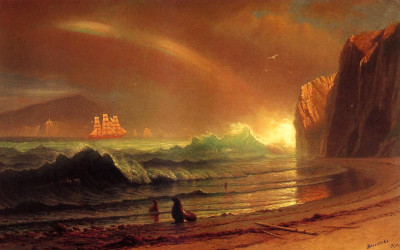The Golden Gate features a series of tall ships making their way through some treacherous conditions whilst out at sea. It's creator, Albert Bierstadt, signed the painting and dated it at 1900, placing it right towards the end of his career.
Light is used aggressively and beautifully within this piece, reminding many of the work of the European Romanticists. A bolt of light strikes across the scene and leads to a flurry of activity on the right hand side of the piece. That part is partially hidden behind tall rockfaces which lead in from the right hand side, cutting off the beach on that side. Several seals can be seen relaxing on the beach itself, directly in front of us. The waves approaching them appear fairly menacing in size, but the seals remain unconcerned such is their familiarity with this environment. There is a dark shade across the foreground, but Bierstadt allows some of the light elsewhere to at least light up a part of the main section of sea, revealing a turquoise tone.
Behind the sea in the far distance we find some mountains, though the artist leaves these fairly subtle. The clouds above are dark and aggressive, covering most of the sky with a thick expanse of purple tones which seem blend closely with other parts of the composition. The Golden Gate feels a little different to what we think of when considering this artist, but that underlines how the painting arrived late in his career, and by now he was seeking to experiment and impress in different ways, with little interest in continuing to follow the same path as earlier in his career. With several decades having passed by since then, he may also have had additional influences within his work and made use of some of these within this newly altered artistic direction.
Some of the dramatic lighting that we find here was perhaps inspired by the Romanticists, such as Turner and Constable. Bierstadt did not travel to the UK as often as some other nations but he must have been aware of their work and the influence that they left behind from their own achievements. Some of the highlights that might have interested him would have included The Fighting Temeraire, Rain, Steam, Speed and The Haywain. This was an important stage in European art, at which point landscape art was becoming far more respected than it was previously, as normally it was only used as a supporting element, rather than a standalone genre and this is something that many today entirely take for granted.




